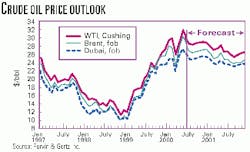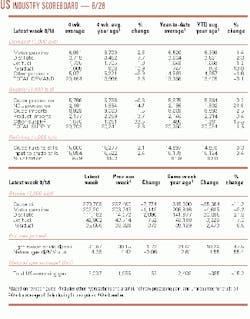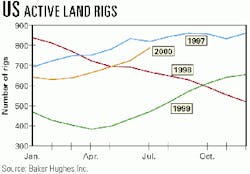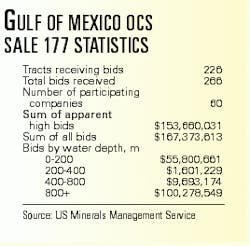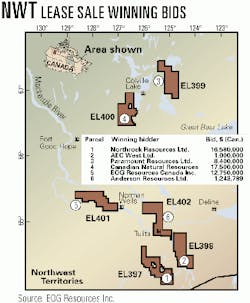Market Movement
Oil price outlook firm, provided...
Oil prices are expected to remain relatively firm, provided there is no further slippage on production quotas from OPEC, Purvin & Gertz said in a July (see chart).
"We presume that no further increases will occur at the September [OPEC] meeting, though legitimization of current output levels could be agreed to," the analyst said. "With stocks of crude and products remaining low due to backwardation, anxieties about winter fuels will affect the trends. Longer-term, building stocks in our balances still lead to weaker prices in 2001."
Purvin & Gertz also notes that recent US crude and product inventory draws over the last few weeks have caused an upward movement in oil prices.
"These draws should not be misconstrued as a shortage of available supply, and the upward move is really unjustified," the analyst said. "Refiners are simply making a prudent move again to reduce buffers in the offseason as backwardation continues. Even distillate market time structure into winter does not support large stock builds. Nevertheless, these factors will keep trade sentiment strong."
Demand declining in developing nations
Signs abound that high energy prices are crimping demand in the developing world.
Energy consumption in the world's developing countries has declined 2.3% over the past year, "seriously" hampering economic and social development performance in these nations.
That is according to remarks Joanne Disan, director of the Department of Economic and Social Affairs' Division for Sustainable Development, made before the UN Committee on Energy and Natural Resources earlier this month.
She noted that this drop was in sharp contrast to the continued trend of rising consumption among OECD countries, where energy demand during the same period stuck to a 10-year growth trend.
OECD countries currently represent almost 60% of total world commercial energy demand, Disan said.
A UN secretary general's report on the coordination of energy activities with the UN system was also updated at the committee session. It was reported that the ad hoc Interagency Task Force on Energy had been "successful in its initial efforts to establish a common, system-wide approach to energy and sustainable development and facilitate regular communication and information exchange."
Current efforts at cooperation with energy sector agencies outside the UN system would further enhance overall cooperation, said the report.
null
null
null
Industry Trends
THE RALLY IN US DRILLING ACTIVITY CONTINUES AS OPERATORS target gas.
After several months of surging natural gas prices, US producers have accelerated their drilling programs-and in turn have pushed the US working land rig count up to 774-which is an increase of 100 rigs since May (see chart).
The rising count can be attributed to an increased interest in gas-directed drilling, which represents 77% of all US rigs, notes Prudential Securities.
Currently, the US natural gas rig count is about 736, an increase of 100 rigs from the 1997 peak, says Prudential Securities, citing Baker Hughes data.
Conversely, the number of US oil rigs drilling has fallen to 210 from 400 during the previous peak. In fact, prior to 1998, the US oil rig count had never fallen below 300, the analyst said. "If oil drilling demand were to rise to the levels of just 3 years ago, we think day rates would expand to levels that would support new construction in order to in- crease domestic drilling capabilities," Prudential said.
A RESURGENCE IN FORMER SOVIET UNION FIELD DEVELOPMENT IS DRIVING GROWTH IN OIL SUPPLIES.
IEA has revised its forecasts of oil supply and demand for 2000, calling its new demand projection "conservative" and its supply prediction "optimistic."
IEA's latest report pegs oil demand in 2000 at an average 75.8 million b/d-a figure lower than its initial forecast for 2000 of 77.1 million b/d, made a year ago. IEA attributes the demand decline largely to declining consumption in the FSU and slowing economic growth in the heavily industrialized countries of Europe.
On the supply side, however, EIA revised its global crude output estimate for 2000 upwards by 600,000 b/d, based mainly on growth in FSU oil supplies from that area's mature fields.
Higher oil prices have favored investment in fields previously considered marginal, said the agency, and "increased industry cash flows [have] contributed dramatically" to the industry rebound, especially in the areas of field maintenance, development drilling, and oil field equipment.
Average 2000 worldwide oil supply, including stockdraws, is now estimated at 75.8 million b/d-or roughly equal to demand.
Government Developments
Independents vying for deepwater gulf ACREAGE continue to dominate Gulf of Mexico lease sales.
That was evident at western gulf Sale 177, held Aug. 23 in New Orleans.
MMS said that the sum of apparent high bids was $153.6 million, up 62% from last year's western gulf lease sale (OGJ, Aug. 30, 1999, p. 36). The highest bid for a single tract was $10,540,800, submitted by Kerr-McGee and CXY En- ergy for Garden Banks Block 624.
"The sale was dominated by independent companies with [Unocal], Kerr-McGee, Amerada Hess, and CXY Energy posting $63 million of the $153.6 million in high bids," said Gulf of Mexico OCS Regional Director Chris Oynes.
Kerr-McGee submitted the most high bids in this sale, followed by CXY Offshore, whose sum of high bids totaled $13,086,576 on 20 blocks. Shell was third on the list, with a total of $4,359,000 for 20 blocks. Unocal had the highest total dollar amount of high bids, at $17,616,760. Unocal also was the company that waved the most money, with $18,792,640 exposed on 22 bids.
THREE FIRMS WON BIDS TO PROVIDE STORAGE FOR A 2 MILLION BBL HOME HEATING OIL RESERVE in the US Northeast.
Pres. Clinton had ordered DOE to establish a temporary reserve by October and asked Congress to make the reserve permanent. Equiva Trading will supply 500,000 bbl of storage space at its Motiva facility in New Haven, Conn.; Morgan Stanley Capital Group will provide 500,000 bbl at its Wyatt facility in New Haven; and Amerada Hess will store 1 million bbl at the First Reserve Terminal at Woodbridge, NJ.
In early September, DOE plans to announce winning bids for supply of the home heating oil to be stored. Storage providers and distillate suppliers will be paid with crude oil from the West Hackberry, La., SPR site.
A PROPOSED IRAN-INDIA GAS PIPELINE via pakistan may be back on track.
India's Foreign Ministry announced a high-ranking government delegation is on its way to Tehran to forge the first joint committee to discuss the transportation of gas from Iran to India. The Indian lobby group is led by Indian First Deputy Foreign Minister for Eastern Affairs K.V. Rajan and includes officials from the ministries of foreign affairs, oil, and defense.
The prospect of a trans-Pakistan gas pipeline tops the agenda for the 3-day meeting. Explaining the prime motivation for the pipeline from Iran to India, an Indian Foreign Ministry spokesman stated: "...As Iran is enjoying rich energy resources, India's need for energy is also increasing, owing to its burgeoning economy."
Last month, Iranian Deputy Foreign Minister for Asia-Pacific Affairs Mohsen Aminzadeh told New Delhi that his government had been "given assurances" by Pakistani officials regarding the feasibility of the proposed pipeline. Aminzadeh called the pipeline "an important economic issue."
Quick Takes
EXPLORATION CONTINUES TO SIZZLE IN CANADA'S REMOTE WEST.
Anderson Exploration was the highest bidder on four parcels in a Northern Oil and Gas Directorate federal sale of lands on the Mackenzie Delta and in the Beaufort Sea that netted $466 million (Can.) in work bids.
Anderson, a joint bidder with Petro-Canada on two other parcels, committed to spend $275 million within 5 years in the recent sale. Also in the sale, Shell Canada acquired one block for $35 million. BP Canada Energy, Burlington Resources, and Chevron Canada Resources made a joint bid of $76.6 million for one parcel. Ana-darko Canada won a single parcel with a bid of $2.4 million.
Meanwhile, EOG Resources Canada reports it was awarded interests in two work bids in the 2000 Central Mackenzie Valley call for bids in the Northwest Territories.
EOG and partners are the winning bidders on Parcel 5, Exploration License 401, covering about 318,000 acres west of Norman Wells. (Other winning bidders are shown in the map). EOG is operator with a 50% working interest in the block and will earn a 17.5% working interest in Parcel 1, EL397, consisting of about 333,000 acres.
In other Canadian frontier exploration happenings, a British Columbia agency plans to review a 28-year-old ban imposed by the Canadian government on exploration off the West Coast.
BC Northern Development Commissioner John Backhouse said the province hopes to begin a review in the fall. Geologists believe there are substantial oil and gas reserves off the West Coast, particularly near the Queen Charlotte Islands, north of Vancouver Island.
A 1998 report by the Geological Survey of Canada said there could be up to 9.8 billion bbl of oil and 1.2 billion cu m of natural gas in the area. Shell Canada, Petro-Canada, and Chevron Canada hold drilling rights in the area (OGJ, Aug. 24, 1998, p. 28).
Elsewhere in the world, ExxonMobil subsidiary Esso Exploration Angola (Block 15) made another deepwater oil discovery off Angola, its eighth oil find on Block 15. The Saxi-1 encountered an oil-bearing reservoir and flowed on test at 5,400 b/d. The well, drilled in 2,200 ft of water to 10,800 ft TD, is about 220 miles northwest of Luanda. ExxonMobil calls Block 15 "a world-class development opportunity with recoverable reserves potential in excess of 3 billion boe." Kerr-McGee's CFD 12-1-2 well, an appraisal of the CFD 12-1 discovery on Block 05/36 in China's Bohai Bay, flowed on test more than 2,700 b/d of 26-34° gravity oil. The 6,896-ft appraisal well, about 1.7 miles west-northwest of the discovery well in 90 ft of water, found pay in Minghauzhen and Guantao sands.
Remington Oil & Gas reports that production casing was set at TD of 17,125 ft in the West Cameron 170 A-6 well in the Gulf of Mexico, which found more than 150 ft of true vertical thickness of oil and gas pay in three sands. The lowest sand interval tested 2,429 b/d of oil and 5 MMcfd of gas through a 16/64-in. choke with 7,525 psi flowing tubing pressure. Production is expected to begin by the end of this month.
TOPPING DEVELOPMENT NEWS, Shell Petroleum Development of Nigeria awarded a $120 million well testing and completion services contract related to development of EA oil field off Nigeria to Nigerian service company Ciscon.
The field, 90 km south of Warri in shallow water, is expected to cost $1 billion to develop. EA field has estimated reserves of 350 million bbl of oil. When fully developed, it will produce 170,000 b/d of oil and about 1 bcfd of gas.
Ciscon will provide services and equipment for the 54 EA wells, the first of which is to spud in April. Shell and Agip will bear up front all costs of developing the field and later recoup the money from revenues.
In other development news, Basin Exploration is hiking its capital budget by 18% to expand its operations in the Gulf of Mexico, where it recently deepened one well and participated in drilling five others. Basin is raising its budget to $100 million because of increased cash flows and improved returns from higher oil and gas prices. Basin deepened its No. D-6 well on West Delta Block 58. When initial drilling was concluded on June 6, the well logged more than 300 net ft of gas and condensate pay in multiple Miocene sands at 11,500 ft TVD. After deepening the well, Basin encountered more than 100 net ft of additional pay in multiple Miocene sand objectives. Basin operates the well and holds a 75% working interest down to 11,300 ft TVD and a 37.5% working interest below that depth. Tengasco completed the newest oil well in its Swan Creek gas field in Hancock County, Tenn., in the upper zones of the field. The Paul Reed/R.D. Helton No. 6 well was completed in Ordovician Stones River from a 56-ft interval. The well is producing 120 b/d of oil. Combined with the production of the other three oil wells in the gas field, Swan Creek is producing 300 b/d of oil.
CHINA'S GROWING EXPORT CAPACITY WORRIES SINGAPORE REFINERS.
Despite Singapore refineries' strong profit margins, driven by record-high gasoline prices, analysts remain concerned about the threat of overcapacity and uncertain demand growth for oil products. In particular, China's transformation into a net exporter of products has the Singapore market worried.
Until last year, China was a net importer of such key products as kerosine and naphtha. It became a net exporter of most oil products this year with the aid of higher refinery runs and a 22-month import ban on gasoline and gas oil.
One energy consultant said that the permanent reversal of China from net importer to net exporter of products would be a "body blow" to the region's expectations for products demand growth.
Among other refining trends, OPEC's only net importer of oil, Indonesia, faces a shortage of refined products after refinery shutdowns caused by accidents over the last 2 months. Indonesia's energy minister visited neighboring countries recently to negotiate contracts to meet the deficit, and Pertamina has been trying to secure fuel supplies from Malaysia, Singapore, China, and India. Shortages of key oil products such as gasoline and kerosine have previously sparked off civil unrest, and Jakarta is working hard to ensure that supplies are not disrupted, despite the country's current production woes. The gasoline shortage resulted from problems at the Balongan refinery, which supplied 80% of Jakarta's gasoline and is undergoing major repairs. Pertamina blames a surge in demand for the tightness in kerosine supplies.
The 31,000 b/d FCC unit at Kuwait National Petroleum Corp.'s Al Ahmadi refinery is back on line. The 440,000 b/d refinery was severely damaged in an explosion June 25 (OGJ Online, June 28, 2000) that also killed six workers. Kuwaiti officials said repairs could take 6 months to complete and would cost an estimated $325 million. In addition to the FCC unit, a gas liquefaction unit and pipeline pumping facilities-including those that help deliver fuel oil and crude to Kuwait's power stations-had all been reactivated. F US DOE will give Petro Star a contract to develop and test a biological approach to removing sulfur from diesel. Petro Star will get $3.2 million in funds for the 3-year project. The firm and its partners will provide another $832,000. DOE said reducing sulfur also would help catalytic converters lower other emissions. DOE said Petro Star proposed a biocatalytic desulfurization process that could help smaller refiners meet the standard less expensively than through hydrodesulfurization. In the first phase, Petro Star and Enchira Biotechnology will work to develop a biocatalyst that can act selectively on the sulfur compounds without degrading diesel quality.
IN THE PIPELINE SECTOR, a natural gas pipeline belonging to El Paso Natural Gas (EPNG) ruptured Aug. 19, causing an explosion that killed 11 people camping along the Pecos River and injured several more. The incident occurred 30 miles south of Carlsbad, NM. Gas flow through the damaged section of pipeline was suspended, and the fire subsequently burned itself out. The cause of the explosion is unknown (see Editorial, p. 19).
An AP report said the explosion left a crater 85 ft long, 45 ft wide, and 20 ft deep. The pipeline was 5-6 ft underground at the rupture point. William A. Wise, president and CEO of El Paso Energy, said, "We are working closely with the National Transportation Safety Board to investigate diligently all matters surrounding this accident and to establish its cause as quickly as possible."
Elsewhere in the pipeline world, Duke Energy International finished building the $297 million Eastern Gas Pipeline in Australia. The pipeline runs from Longford, Vict., to Sydney. Among other commitments, the 495-mile natural gas pipeline will supply gas to fuel the Sydney 2000 Olympic Games. It will have an initial capacity of 173 MMcfd to deliver gas to regional and metropolitan centers in New South Wales and Victoria.
Pioneer Pipe Line began construction of a 262-mile expansion of a pipeline carrying refined products from refineries in Montana and Wyoming to Salt Lake City. Pioneer Pipe Line is jointly owned by Conoco and Sinclair Oil. Sunblind Construction and G.B. "Boots" Smith were awarded contracts to replace the existing pipeline, which was built in the 1950s. When completed, the expanded pipeline will transport an additional 23,810 b/d of gasoline, diesel, and jet fuel. The project, to be completed later this year, will replace an old 8-in. pipeline with a new 12-in. pipeline and increase capacity from the existing 47,620 b/d.
Nigerian National Petroleum Corp. started an enlightenment campaign to dissuade communities from engaging in pipeline vandalism. Uti Ntofon, the chief maintenance engineer for the Port Harcourt area, disclosed that 524 incidents of pipeline breaks were recorded in 1999. Twenty-seven were due to corrosion, he said, while 497 cases arose from vandalism. During the period to May 2000, Utofon said that about 1,500 people lost their lives in the course of vandalizing NNPC pipelines, while trying to steal petroleum products.
ANOTHER ORINOCO HEAVY OIL MEGAPROJECT MARKS A MAJOR MILESTONE.
Texaco and its partners in the Hamaca heavy oil project in Venezuela's Orinoco Belt, PDVSA and Phillips, unveiled three major engineering, procurement, and construction contracts, valued at $1.074 billion, to consortia led by Fluor Daniel and Venezuela's Inelectra/Parsons.
Texaco has authorized two contract awards totaling $1.011 billion for the engineering design, equipment procurement, and construction of oil upgrading facilities at Jose, Venezuela. The facilities will process the 8
Texaco awarded a third contract to develop field production facilities, valued at $62.45 million. The Hamaca project is expected to produce 190,000 b/d of crude by 2004.
In other production action, flow started from Statoil's Heidrun north flank development in the Norwegian Sea.
The project is part of Statoil's 5.6 billion kroner Heidrun plateau program. Output from the north flank will extend plateau production from the Heidrun TLP to 2004. Located 4.5 km northeast of the TLP, the north flank installations include three seabed templates with 11 production and injection wells. Two producers are being brought on stream with their well streams piped to the TLP, which was fitted with 1,400 tonnes of additional equipment to handle north flank output.
Total production from the north flank will start at 38,000 b/d. Heidrun is currently producing 190,000 b/d.F Santos says oil production from Stag field in the Carnarvon basin off Australia increased in recent weeks because of stepped-up field development activity. In that time, production exceeded 30,000 b/d of oil on five occasions and achieved a rate of 31,000 b/d, vs. a second quarter average of 22,790 b/d. The increase, said Santos, comes from drilling Stag 21-H well and sidetracking Stag 15-H. - Heidrun TLP. Photo by Svein Harald Ledaal, courtesy of Statoil.
NL BULLETIN
Soaring oil prices may have come too late to avert both a collapse in non-OPEC oil supply growth and a new rig market famine next year, says Petrodata Research.
Although oil companies have been flush with cash for the last year, this new money is being spent not on drilling wells but rather on "defending their balance sheets, buying back shares, and competing with high-growth technology stocks," Petrodata analyst Maarten van Mourik told Offshore Northern Seas 2000 delegates in Stavanger last week.
He contends the current state of the market and "underlying pressures" are signaling a repeat of the 1995-98 cycle, which ended in the oil price crash and pan-industry recession.
"The portfolio of new developments has dried up so much that it is hard to project increases in non-OPEC oil supply for 2001," he suggested, resulting in OPEC having to take up the slack.
The spending drop over the last 2 years is also hitting deepwater rig markets, says Van Mourik. He believes oil company plans for fast-tracking new frontier field developments will likely be "too optimistic" in the light of an imminent rig market squeeze.
"Poor day rates have made contractors wary of committing to further building of new rigs," he said. "As a result, we predict that the available fleet will be insufficient again shortly to cope with increasing demand and develop the potential of all those deepwater fields.
"The ultradeepwater segmentellipseis the leading indicator here, and that segment is already in physical shortage," Van Mourik added.
